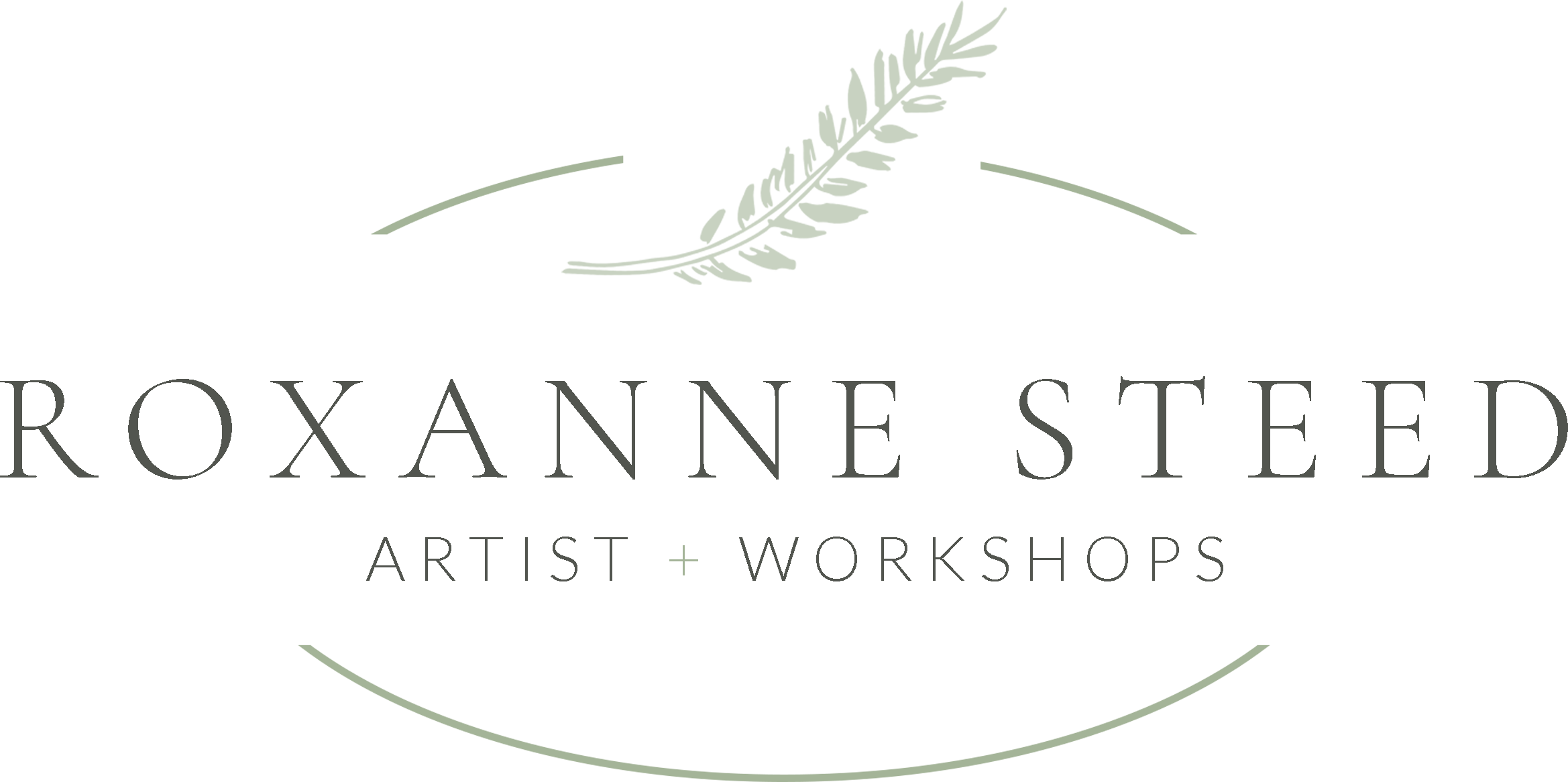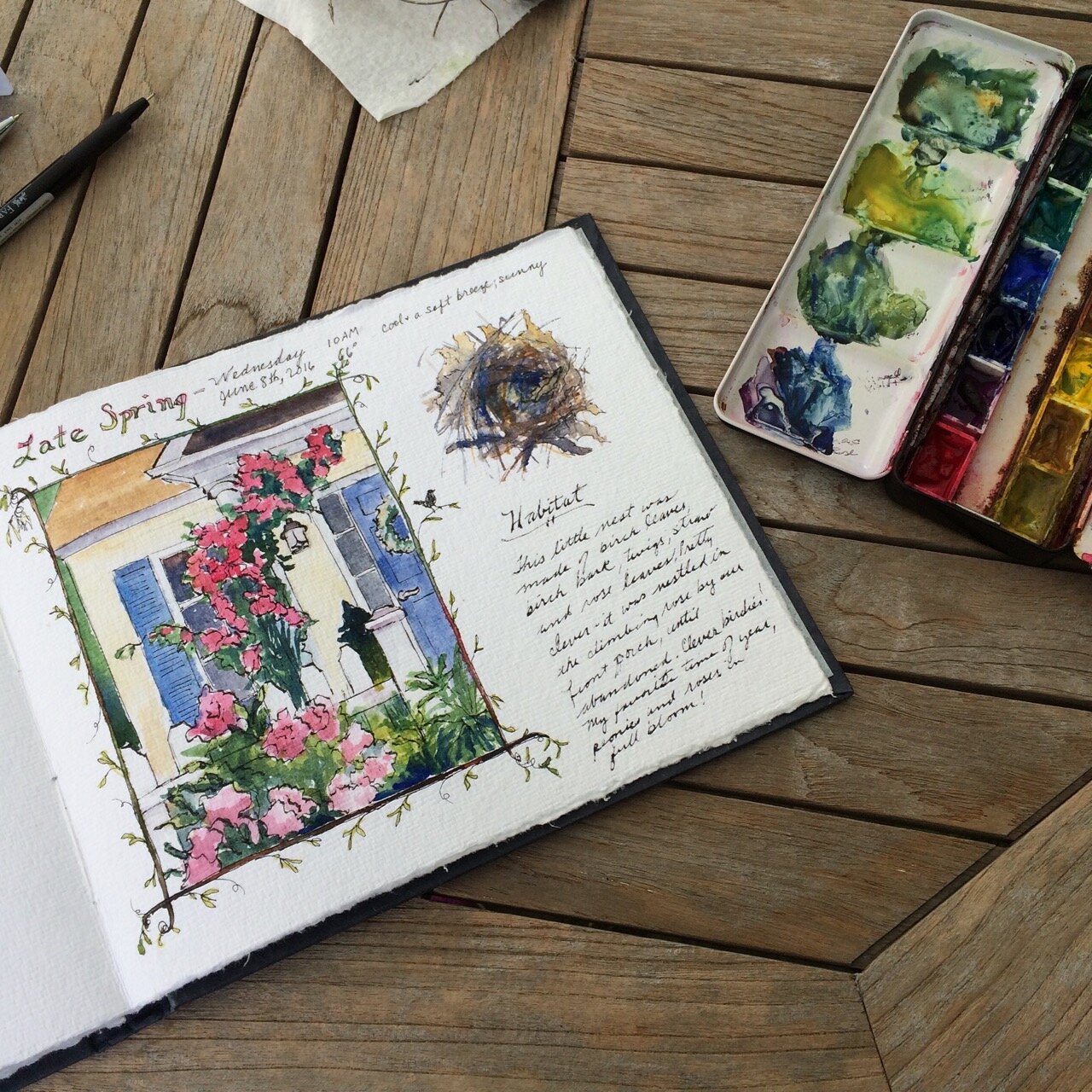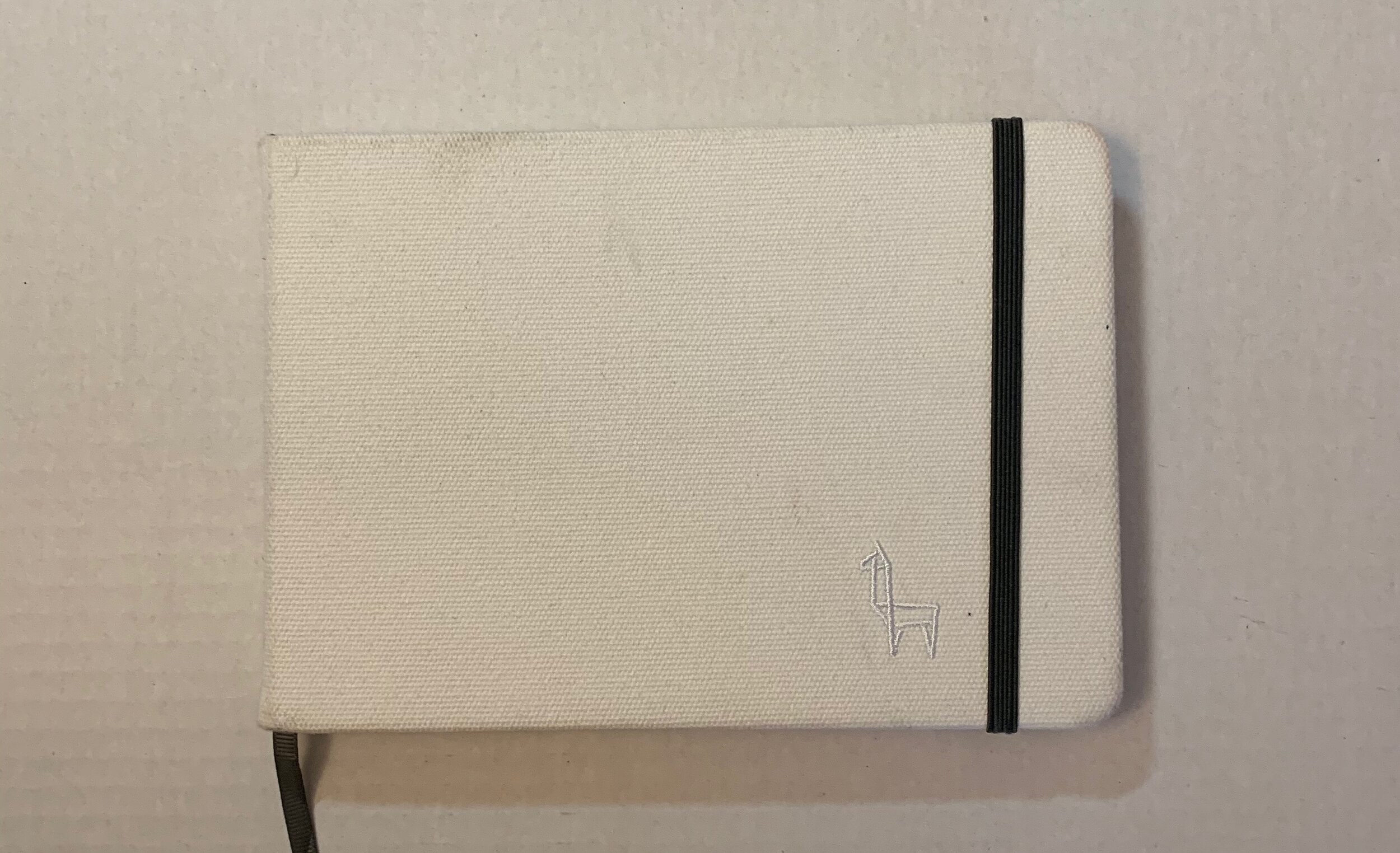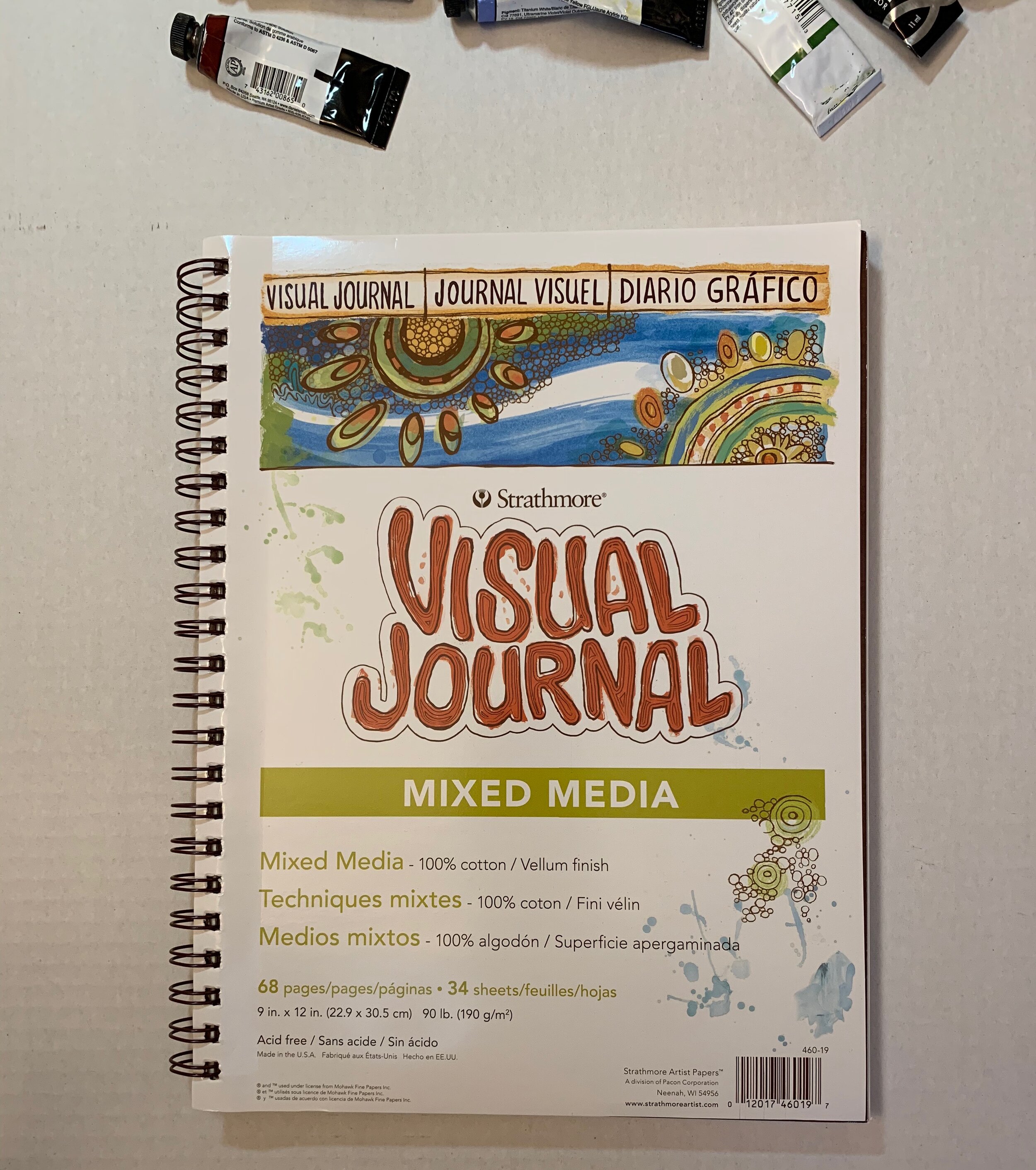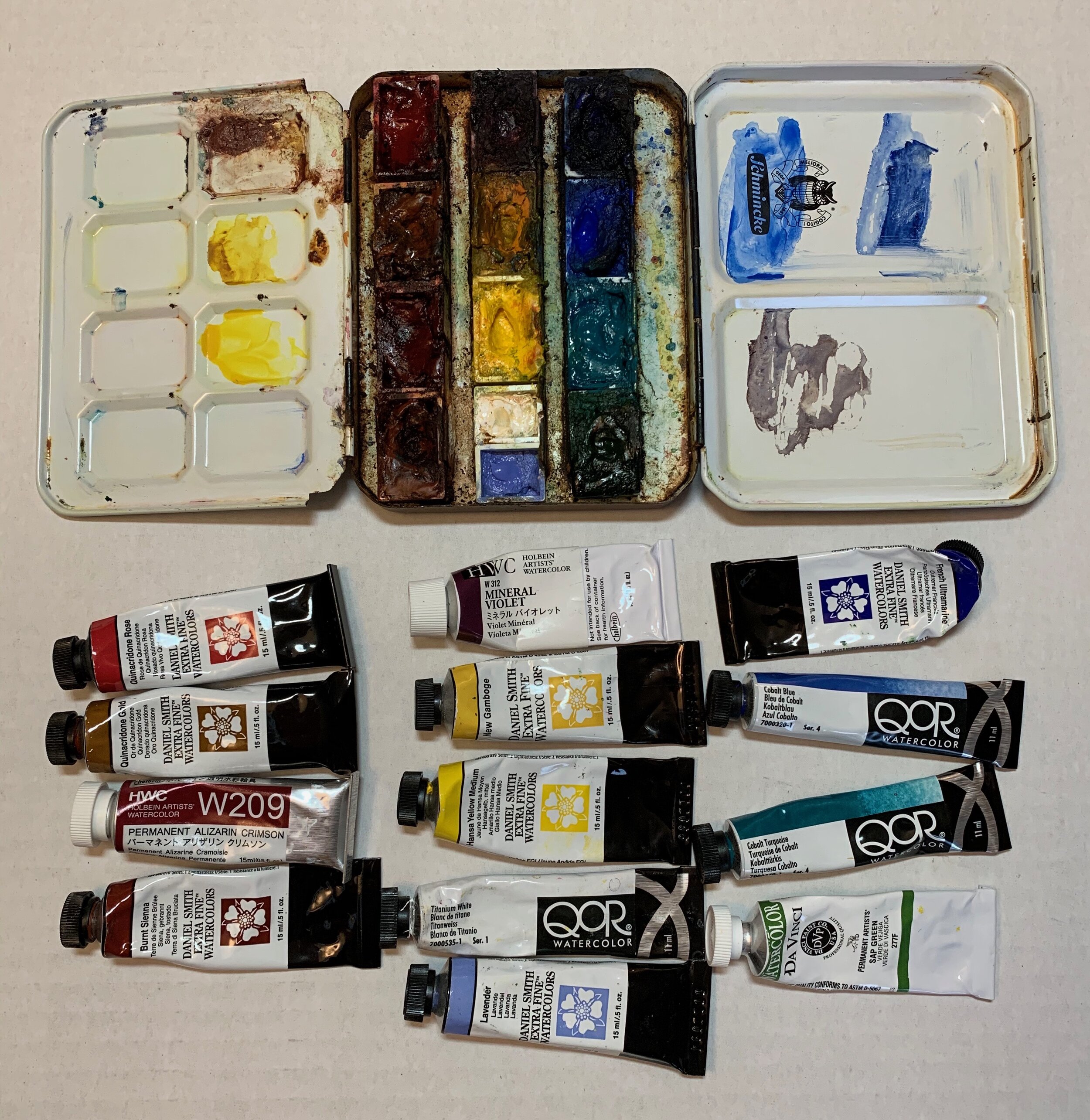What supplies do I need to get started painting with watercolors and sketchbook journaling?
Painting is such a meditative activity. And the nice thing is- anyone can do it! YES- I can teach you how!
When I have new students come to take my classes, or some that have perhaps painted before, but want to continue their art journey, I send out a supply list. And I have 2 different lists. One is the ‘Basics’ which includes some ‘student grade’ supplies - but the brands I’ve listed are actually pretty good! I’ve tried them out, so I know how they perform. When I started painting over 35 years ago, no one told me the difference between student grade supplies and professional supplies, but I knew one cost a lot more. At that time, (as a stay at home mom with twins in diapers) I didn’t have the cash to spare, or much time to spend much time exploring the difference. After seeing what’s out there on the market these days, I’ll admit - there are some supplies you won’t want to waste money and time on! I want to help you avoid those!
************Below you’ll find links to Amazon to directly purchase my favorite supplies. I earn a tiny percentage from Amazon without it affecting the price to you.
For those who are ready and interested in purchasing artists/professional grade supplies I’m listing those, too. Those are the paints and paper that I use most. When it comes to paints- the difference in some of the poor quality student grade paints (I’m not even listing them here, but usually you’ll see they are marketed to kids, and have a clear plastic lid on them, and look almost like round circles of eye shadow). Those student grade paints have a high binder to pigment ratio - so while the color/hue may be similar, it will have a very chalky look, and won’t behave in the same way as the artist watercolors.
Now, when it comes to paper - cotton is KING! Paper is made out of either 100% cotton or wood pulp. I find that difference makes the paint flow smoother. When I see people struggling I can usually quickly see, it’s the paper causing most of the struggle! Remember, “it’s not you, it’s the paper!”. So when you start out with good supplies, you are already miles into the game, and your progress in learning will be much easier and quicker…since you are not fighting with supplies.
Lastly, I see myself mostly as a plein-air painter. Meaning - I like to go paint on location, and I like to keep my supplies light in weight and easy to maneuver yet excellent in quality. So I won’t be covering studio supplies/larger sized palettes in this entry. That’s another post for another day! Here’s the list of basics, note that some are the same thing in my ‘favorites’ list. Some of the student grade or less expensive materials I use for class demos and practice/scraps. I’ll note those below.
Basic Supply List for Sketchbook Journaling:
pencil - I like mechanical pencils with an eraser built-in. No need to carry a sharpener!
kneaded eraser - erases and picks out bits of graphite from your paper without leaving crumbs, etc. self-cleaning when you ‘knead’ it back into itself.
permanent waterproof black drawing pen- I like the Molotow brand, (other brands seem to run dry too quickly)
Basic Watercolors- this one is a nice travel set with lots of mixing room in the palette of this ‘compact for travel size’. Winsor Newton Cotman is the student grade version of these - and they are a GREAT place to start if you’re not sure you’re in this for the long haul. And if you are, this palette is a keeper. When you use up all your paints, you can buy professional grade tubes to fill up the pans with. This is a perfect place to start and they’ll go a long way!
OR- Professional grade travel pan set - This is a classic ‘field box’ which is great for keeping things portable and small, yet holds professional grade paint - a Winsor Newton classic. Same great little box.
Watercolor brushes - a round brush, size 6 & a size 10 will take you a long way. If you get a travel brush, they come with a built in cap to protect the bristles while it’s sitting in your paint bag. I like the da vinci synthetic brushes. The current day synthetic brushes are great- they hold a lot of paint in the belly of the brush, and hold a nice fine point for detail. Here are 2 very handy ones for travel: the size 6 travel brush I like - and the size 10 travel brush I like. These are both the Davinci cosmotop spin brushes. They also have a newer fiber one, called the Casaneo New wave synthetic, which I love! Also a synthetic, the fibers are formed to be wavy, so it holds even more liquid in the belly of the brush. The first two that I’ve listed are delightful, but if you want to add one of these to your arsenal - I think you’d really love it, too. Here’s the size 8 Casaneo, and a size 2 Casaneo to round things out. Kolinsky sable brushes are wonderful. The natural hairs hold a lot of liquid in the belly of the brush. Which means it feels ilke you can paint, paint paint before having to dip up another load of paint. They are truly a delight to use. They are also very pricey. Which means I have only one, and it is over 25 years old, and the point is wearing off after all its years of use. The thought of dropping it off of a dock into a river, or off the side of a cliff has kept me from buying another one. Not that I’ve ever dropped any of my supplies off the side of a cliff or a dock, but you get the idea. I do use that old one in my studio though, and it is a delight, but I sure miss the point that’s been worn down. The current day synthetic brushes are great though! If you’d like to give it a go, try out the size 5 Kolinksy travel brush.
Sketchbook - this one’s great for travel, too! This one made by etchr_lab is a true delight. The paper is 140 lb. cold press and 100% cotton. This one is 8.3” x5.8” and is an easy fit for your travel bag. If you want to go a little larger, here’s the next size up of the etchr sketchbook. It’s 8.3”x11.7” and all 100% cotton paper with a cold press surface.
I also recommend a less expensive ‘practice’ book which I’ve found to be the ‘best bang for your buck’. It’s a mixed-media paper, but YES- it’s 100% cotton. It’s the Strathmore Visual Journal for MIXED MEDIA. (note- don’t get the ‘Watercolor’ one, it’s NOT cotton, but wood pulp instead, and it just doesn’t handle the paint in the same way!). I use this paper for class demos, and for trying out color mixes, and yes, sometimes even beautiful sketch pages. It’s a perfect place to try get started. You can get a lot of ‘brush mileage’ here and not feel like you are going to break the bank. ***PLEASE NOTICE- This says ‘Mixed Media’ on the cover - that is the one that’s 100% cotton. Oddly enough, the ‘Watercolor’ version is not! Paper is made of either cotton or wood pulp, and it it’s not marked 100% cotton, it’s NOT!
Next- if you’d like to expand your horizons a bit:
If you’re looking to try the professional grade paints, I highly recommend it. The biggest difference between the professional/artist grade paints and the student grade paints is that the artist grade paints have more pigment and less binder - so the colors and behaviors of the paints are more true and reliable. The student grade paints have a lot of binder (filler) and less pigment - so some of these end up with quite a chalky look to them. They just won’t perform as their professional counterparts do. That said, some student grade paints are better than others. My favorite artist grade `brands are Daniel Smith, Winsor Newton, M. Graham, Holbein, Sennelier and Qor. They have been reliable and beautiful paints.
To carry around your tube paints, you’ll want a travel palette to carry them in. Looking for one that’s ‘not too big, not too small’ is like Goldilocks finding the ‘just right oatmeal, and just right bed in the house of the three bears! Too big and you’re going to get a hand-cramp trying to paint with this on location. Too small and you won’t be able to paint much of anything at all. I favor the metal ones, as I like the surface and how the paint sets on the surface
Here’s a link to a small palette that I have my eye on to try when my current one rusts through. It’s similar to one I’ve had in the past that I liked. (Those 3 segmented pans on the side are really a nice size - not too big, not too small). This one is similar to a previous palette that I loved and used for many years until it rusted out. I filled it with whole pans instead of half pans. The palette I’m currently using is no longer available online, but is fairly close to this one, and again, I’ve used whole pans instead of half pans of paint.
And now- for the paint!
Here are the colors I’m currently using, and a link so that you can go shopping in your jammies after midnight! (doesn’t everyone do that anymore?).
Some favorite brushes in the studio:
-Princeton velvetouch (series 3950) , here’s a set that includes a size 4 & 8, and a 3/4”flat and a 3/8” angled shader brush (great for painting roses). These are some really nice synthetics that hold a lot of liquid in the belly and hold a great fine point.
-Escoda versatil, size 10 rigger. This has long bristles which can be very expressive in landscapes
-a good mop brush - for spreading water or paint around over a big territory
The best paper for studio practice (or plein air)
-These brands hold up well and are 100% cotton 140lb watercolor blocks
-Fabriano Artistico, 140lb cold press
These supplies listed are my personal favorites that I’ve used for many years. From time to time I may add to/or delete from the list as I try new materials.
Stick to artist grade supplies and you’ll be much happier with your results.
And remember- brush mileage is the best thing to grow your skills! Enter this learning curve with that ‘fearless sense of play’ that children have, and you’ll see your skills and your confidence grow over time.
